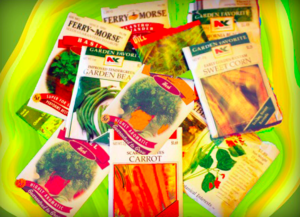
If you're buying seeds rather than collecting them directly from plants, it's useful to have an idea of the things to look out for when in the garden centre or perusing hard copy or online versions of seed catalogues. This article provides a few suggestions of things to be aware of.
Things to note when buying seeds[edit | edit source]
- Have a list of the seeds you wish to purchase. This will help prevent you from over-buying, reminding you that there is only so much garden or field space. Also bear in mind that over-stocking on seeds is not recommended, as fresh seeds are always the most viable and storing seeds is tricky and if not done per the seed's exact requirements, storing can cause the seeds to become nonviable for the following season. (For example, absentmindedly leaving seed packets in your kitchen area can subject them to moisture, temperature extremes and drying out, all within a few winter months.)
- Do some research on what grows well in your area. This will save you the disappointment of buying exotic seeds that fail to thrive as plants. Some seed companies will specialize in regional plants or plants suited to various areas in a country. This information should be available on their website.
- Compare prices. This is easy to do when looking online, although it can be time consuming (but enjoyable). Select three or more companies that sell seeds and download or open their seed catalogues. These may be in PDF or Word form, making it easy to scroll through them, although some catalogues may only be kept online.
- Check the date of the seeds. This should be marked on the seed packet or indicated in some manner if the seeds are in bags or other containers. Ask the retailer if this hasn't been made clear.
- If growing organically, be sure that the seeds are not treated with fungicide derived from synthetic chemicals. This should be stated on the packet, or you can ask the seed company.
- Find varieties of plants that will meet your needs. Important things to consider looking for include disease-resistant varieties and varieties with sufficient yields for your needs.
- Check the quantity of seeds in a packet or bag. Allow for some seeds to be duds, so a few additional seeds is fine in order to ensure that you get the crop you're after.
- Consider seed mixes where you'd like a variety of plants in one space. The type of plants in such mixes (often lettuces, wildlflowers, etc.) will have been selected by the seller to ensure their compatibility in growing closely together.
- Don't forget the space you have. Although already stated, it cannot be over-emphasized that falling in love with more plants than you have space for will result in wasting money through crowding, loss of viability or inability to plant some of the seeds.
- Look for sufficient information on growing the seeds. Most seed packets and catalogues will provide growing information, such as conditions, distance, depth, maturity time, etc. This can be helpful in ensuring that you give the seeds the best opportunity to germinate and thrive. You can also ask the retailer or email/call the seed company.
Reading seed packets[edit | edit source]
Most standard seed packets carry standardised information which can inform you not only about the contents but also the growing conditions. The following items are usually found on a seed packet:
- Variety name: This will usually be printed on the top, perhaps also on the flap and it will be in large letters.
- Planting information: This provides the guidance for planting the seeds and tending to them. It can include direct-sow/indoor sow guidance, depth, distance between seeds, instructions for transplanting and/or thinning seedlings, length to germination and maturity and when the plant can be harvested.
- Date: The date by which the seeds should be planted should be evident. If missing, ask the retailer or seed company. If you buy seeds close to the end date, ask for a discount. If past the end date, ask if they'd like to donate them to you.
- Planting map/zoning: This will show you pictorially where in your region or country the seeds can be planted, along with the seasonal times for regions that are ideal for sowing. Note that these are very broad indications and localised variations are to be expected, as learned by your own experimenting.
- Amount of seeds: The packet will usually tell you how many seeds to expect, as a minimum. This may be approximate, especially with smaller seeds. Sometimes weight is used in place of individual count.